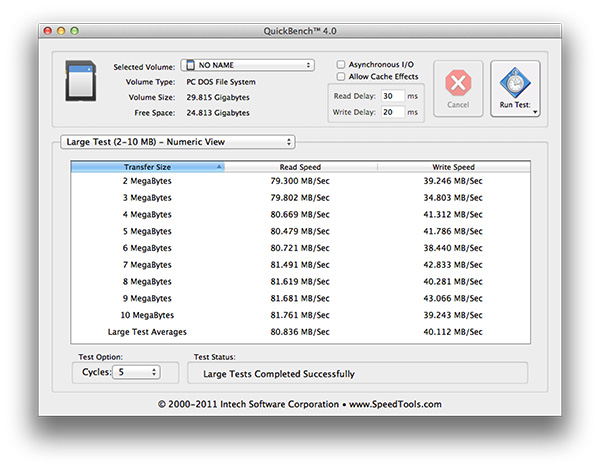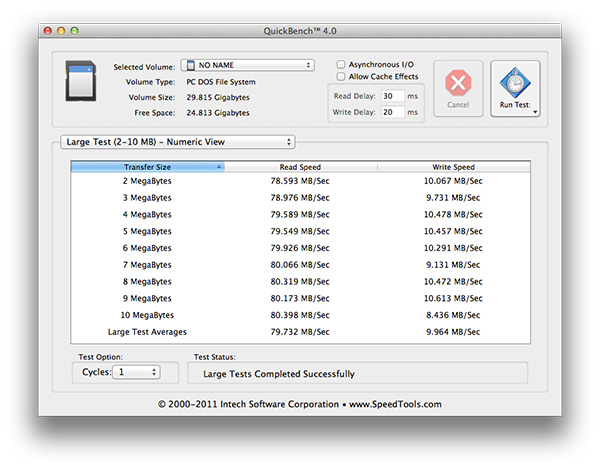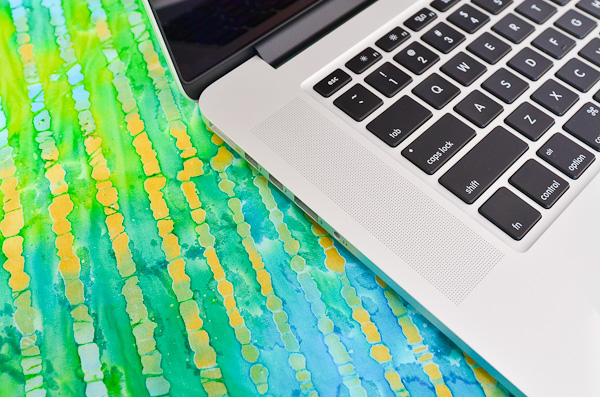The next-gen MacBook Pro with Retina Display Review
by Anand Lal Shimpi on June 23, 2012 4:14 AM EST- Posted in
- Mac
- Apple
- MacBook Pro
- Laptops
- Notebooks
WiFi Performance
The next-gen MacBook Pro is equipped with a decidedly this-gen wireless stack. In other words it uses the same 3x3:3 WiFi solution that was present in the 2011 MacBook Pro and is present in the non-Retina 2012 MacBook Pro as well: Broadcom’s BCM4331. The wireless behavior characteristics are a bit different since this is a physically different chassis, but we’re still dealing with a 3-stream 802.11n solution - not 802.11ac. All three antennas are located in the Retina Display’s housing.
We have seen Apple be conservative with component choices in the past. Deciding to stick with Samsung’s 45nm LP process for the A5X instead of embracing 32nm LP sooner with the 3rd gen iPad is one example that comes to mind. Like a good silicon company Apple appears to mitigate risk in design by sticking with known-good components wherever possible. Major changes to the industrial design are typically paired with comparatively minor silicon changes, and other components are kept as static as possible so long as they don’t overly compromise experience. While 802.11ac dongles and routers are just arriving today, Apple likely froze the Retina MBP’s wireless configuration quite a while ago. Rather than be caught shipping potentially unratified hardware, Apple went the safe route and stuck with 802.11n.

That’s not to say Apple’s wireless implementation is bad. The 15-inch MacBook Pro has been one of the best behaved notebooks on wireless that I’ve had the pleasure of using. The MacBook Pro with Retina Display is no different. Just like before, the best case negotiated physical rate is 450Mbps when paired with a 5GHz 3x3 access point. Unobstructed, within a couple of feet of the AP, I measured as much as 230Mbps to the Retina MacBook Pro. I tested at three different distances from the AP, through walls and on both 2.4GHz and 5GHz bands. Overall performance seemed comparable to the standard 15-inch MacBook Pro, although it’s definitely faster in some areas and slower in others.
| Location 1 | Location 2 | Location 3 | |
| 2011 MacBook Pro (2.4GHz) | 124.0 Mbps | 12.6 Mbps | 61.6 Mbps |
| Retina MacBook Pro (2.4GHz) | 117.9 Mbps | 87.6 Mbps | 44.0 Mbps |
| 2011 MacBook Pro (5GHz) | 186.8 Mbps | 154.6 Mbps | 24.7 Mbps |
| Retina MacBook Pro (5GHz) | 227.7 Mbps | 156.8 Mbps | 33.7 Mbps |
The second test location consistently performed poorly on the 2011 MBP, only on 2.4GHz however. For the most part there were no real surprises otherwise.
The SD Card Reader
It was our own Brian Klug who clued me into the horrible behavior of the 2011 MacBook Pro’s SD card reader. Depending on the SD card used, the integrated SD card reader either performed admirably or was the most frustrating part of the Mac experience. Out of the three SD cards I frequently use: a Patriot LX series card, a Transcend and a new UHS-I Patriot EP Pro, only the Transcend card actually works remotely well with the 2011 chassis. Even then, it’s not perfect. I usually have to insert and remove the card at least once before the reader will recognize it. The LX and EP Pro on the other hand are measurably worse. To get the EP Pro to work in the 2011 MBP’s reader I usually have to push the card in then apply upward or downward force to the exposed edge of the card to get it to read properly. Even then it’ll usually disappear from OS X or be present but read at bytes per second. I doubt this is the fault of the card itself but rather the latest example of incompatibility with the horrible SD card reader in last year’s MacBook Pro.
At least with the cards I’ve tested, the Retina MacBook Pro exhibits none of these issues. Over dozens of insertions I had no issues reading from or writing to all three of these cards, including the problematic ones. I ran a Quick Bench test on the EP Pro as it’s the fastest of the lot and came away with reasonable performance as well. Roughly 80MB/s reads and 40MB/s writes. The numbers are shy of Patriot’s 90/50 spec but quite good.
One of the times I was able to get the EP Pro working in the 2011 MacBook Pro I managed to squeeze in a single Quick Bench run. Read performance was almost identical at 80MB/s, but write performance was far lower at only 10MB/s:
Shortly after the test completed I could no longer write to the drive in the 2011 MBP so I suspect the card reader was acting up again. Needless to say, if you like using SD cards with your MacBook Pro the Retina Display model appears to be much better. That’s not to say there couldn’t be other incompatibilities, but in everything I tested it looks like this problem is finally fixed.
Better Speakers and Dual Mics
Apple is proud of its new speaker design in the Retina MacBook Pro. There’s not a whole lot you can do for tiny laptop speakers but despite shrinking the overall volume of the chassis, Apple has managed to deliver much better sound out of the new speakers in the rMBP. Like most of the upgrades to the next-gen MacBook Pro, you really need to do an A/B comparison to appreciate the difference. And keep your expectations in line with reality, a good set of external speakers are always going to sound better. With that said, the new speakers definitely deliver a fuller, more rich sound than their predecessor. You can still tell you’re listening to some form of integrated speakers, but now they sound distinctly less like they’re coming from a inside a notebook.
In preparation for Mountain Lion's arrival with dictation support, Apple outfitted the next-gen MacBook Pro with dual microphones in order to better focus on your spoken voice and not on background noise. In practice the new mics work reasonably well, rejecting moderate volume background noise. Loud music nearby will still cause interference and as always, accurate dictation requires more than just good quality source audio to get right.













471 Comments
View All Comments
Kill16by9TN - Sunday, June 24, 2012 - link
What I don't understand, how does it make any sense, to use scaling factors resulting in 16:9 (TV/movie) resolutions (2560x1440, 2048x1152, 1600x900) on a 16:10 computer panel with native 2880 x 1800, or scaled down, 1440 x 900 pixels.ImSpartacus - Sunday, June 24, 2012 - link
They aren't. In OSX, you can have 1440x900, 1680x1050 or 1920x1200. Those are all 16:10.Kill16by9TN - Sunday, June 24, 2012 - link
Sorry, looks like my bad. I was so baffled by those 16:9 resolutions in the settings window screen shot, that I completely missed that window's "Thunderbolt Display" title and the monitor icon on the left.So apparently Anand was using a an external 16:9 monitor for this test and everything is fine again ;-).
yottabit - Sunday, June 24, 2012 - link
I just want to take a moment to say thanks for always sticking to the philosophy of not releasing a review until it's ready. Even though other reviews of the Retina display MBP have been up for a while I honestly didn't even read them because I love waiting for what Anand is going to come up with. I still count on Anandtech as my "one-stop-shop" for reviews and I've got to say it does not disappoint.I know people are complaining about the lack of upgrade potential on the retina Mac Book Pro, but I think it's Apple's right. Think about it- they now have a product that is truly unrivaled in any category. Until some other competitors can put pressure on them, I don't think we'll see upgradeability come back into play.
Apple has done something really tremendous here with their retina display panel, I think this is the longest head start they will have ever had on anyone since the iPod. With all the proprietary graphics drivers/GPU scaling, and the development of this custom display at this pricepoint, I really think it will be years before we see a PC with a similar overall package. So long as Apple can maintain exclusivity with it's suppliers (and that's never been a problem in the past)
This display isn't something somebody can just knock off, it's an engineering marvel IMO. And it's going to be hard for any other OEM to justify the volume to market a display like this.
Reading about Apple's influencing Intel to speed up iGFX development sent chills down my spine. I can't believe how much Apple has grown.
I've got to say I think Steve Jobs would be really proud of the launch of this device. I don't think many people realize how big this is going to be!
shushamen - Sunday, June 24, 2012 - link
Anybody knows how the Xcode iOS simulator handle the retina display , I meant what happened when you selected iPad retina, does it scale it or use a pixel to pixel.Currently I am using an imac 27 for iPad dev and even at 2560 x 1440 I have to scroll inside the iOS simulator when target iPad retina ( I know I can use the sim scale option ), I am hoping that with this new MBRD I can solve the issue.
Baked - Sunday, June 24, 2012 - link
How many times do you the cleaning lady come over to dust your mansion? Or do you have live in crew? I'm guessing the latter.Must be nice being so filthy rich.
dtolios - Sunday, June 24, 2012 - link
People talk about "creative laptops" vs. consumer laptops, innovation etc...Apple has been pushing things around for a long time - and failed BIG in the process. And no, not because it was innovative, but because of proprietary stubbornness: be different at all costs. It's not about "creative users"...it's about "wannabees", and that's what 95% or more (guesstimation) of all the MBPs out there are and will be used for. Showing off while browsing FB and tweeting (instead of being creative) in schools and cafes.
The rMBP is a good start for something great, no doubt, and I am happy that all these vanity addicts will fund more and more of the good stuff to grow and mature (cause obviously the screen scaling application has to work a long way to reach enough potential to be used in creative stuff).
Till then, I hope the rMBPs with all the proprietary hardware connections/integration won't make a lot of proud buyers to cry with increased reliability issues and zero user-end customization/repair/replace support ( you know, MBPs have been far from the best in this field already, and it looks it will get lost)...I will be waiting for a year or so to hear what Apple service will ask for a blown MoBo.
robco - Sunday, June 24, 2012 - link
Huh?Apple's sales have outpaced the industry for some time now. Their sales of notebooks has gone up considerably. The MacBook Air is becoming quite popular. If that's failing big, most companies would love to fail that much.
The standard 2.5" form factor wouldn't fit inside an Air or the new rMBP. So Apple had to do their own thing. That's not Apple's fault. The same is true with SO-DIMMs. As for reliability and service, Apple tends to get top marks there too. I have taken my current 2009 MBP in twice. Once to fix a sticky trackpad that wouldn't click, and once to replace the battery. Both times the machine was fixed, under warranty, quickly. I made an appointment, dropped by the Apple Store and they took care of it. Easy.
Apple is not stupid. They've been making the new Air for some time now. If they were constantly replacing blown mobos and components were failing all the time, they wouldn't still be making them. I know quite a few MacBook users and they all have found them to be durable, reliable machines. Most people will likely move to the new Air because they don't need the CPU and GPU power of the new rMBP.
spronkey - Sunday, June 24, 2012 - link
Listen to what you're saying.#1 They designed a machine ignoring existing standards. It's not like they *couldn't* have made a very, very similar machine that used standardised parts. They just chose not to.
#2. SODIMMs? What about pitching a new standard, then? Or how about adding 1mm. Noone would have noticed, and then in two generations they can thin it out even more.
#3. Warranty. Perhaps in the US Apple are good with service. Over here in New Zealand they don't exist - we get Authorised Apple Service Providers, who try their absolute hardest to weasel out of fixing anything, and whose first mandate is to never admit design faults like those that exist with the original MagSafe connectors!
#4. What happens when the machine drops out of warranty? Let's not forget that Apple's 1 year standard warranty isn't exactly generous. Oh wait - Apple want to gouge you some more by offering AppleCare. But it's not just an extended warranty, it comes with all this other crap you don't want, like phone support. And it's four times the price of a retail store's extended warranty.
How about they put their money where their mouth is and start backing up their "superior" devices with superior warranties. Oh, and while they're at it, they can stop price gouging other countries by picking ridiculously low exchange rates to use...
robco - Sunday, June 24, 2012 - link
They do make a similar machine using standardized parts, they still sell the non-retina MBP. It has a standard 2.5" drive bay and SO-DIMMs. It also is larger and heavier. They wanted to slim down the machine and cut down on weight, these were the design trade-offs they had to make.As for warranty, AppleCare costs $50USD more than Dell's three-year warranty upgrade for an XPS 15, expensive but not out of line. For major defects that happen out of warranty, it depends. Apple has made repairs and replacements in the past with battery issues and faulty GPUs.
As for international support, outside major European and Asian countries, it is pretty crappy. It's going to take some effort on Apple's part to improve that. Also bear in mind that we don't have a 15% GST in the US. Our sales taxes vary from state-to-state (some don't have one), so it's not included in the retail price. Here in CA, the price jumps from $2199USD to $2393.92 with $186.92 in sales tax. Not as expensive as the 15% GST in NZ.